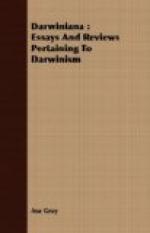An elaborate paper on the vegetation of the Tertiary period in the southeast of France, by Count Gaston de Saporta, published in the Annales des Sciences Naturelles in 1862, vol. xvi., pp. 309-344—which we have not space to analyze—is worthy of attention from the general inquirer, on account of its analysis of the Tertiary flora into its separate types, Cretaceous, Austral, Tropical, and Boreal, each of which has its separate and different history—and for the announcement that “the hiatus, which, in the idea of most geologists, intervened between the close of the Cretaceous and the beginning of the Tertiary, appears to have had no existence, so far as concerns the vegetation; that in general it was not by means of a total overthrow, followed by a complete new emission of species, that the flora has been renewed at each successive period; and that while the plants of Southern Europe inherited from the Cretaceous period more or less rapidly disappeared, as also the austral forms, and later the tropical types (except the laurel, the myrtle, and the Chamaerops humilis), the boreal types, coming later, survived all the others, and now compose, either in Europe, or in the north of Asia, or in North America, the basis of the actual arborescent vegetation. Especially “a very considerable number of forms nearly identical with tertiary forms now exist in America, where they have found, more easily than in our soil—less vast and less extended southward—refuge from ulterior revolutions,” The extinction of species is attributed to two kinds of causes; the one material or physical, whether slow or rapid; the other inherent in the nature of organic beings, incessant, but slow, in a manner latent, but somehow assigning to the species, as to the individuals, a limited period of existence, and, in some equally mysterious but wholly natural way, connected with the development of organic types: “By type meaning a collection of vegetable forms constructed upon the same plan of organization, of which they reproduce the essential lineaments with certain secondary modifications, and which appear to run back to a common point of departure.”
In this community of types, no less than in the community of certain existing species, Saporta recognizes a prolonged material union between North America and Europe in former times. Most naturalists and geologists reason in the same way—some more cautiously than others—yet perhaps most of them seem not to perceive how far such inferences imply the doctrine of the common origin of related species.




